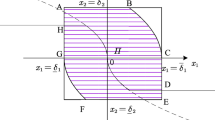Abstract
This paper proposes a fault-tolerant control scheme for the quarter active suspension systems with uncertainties and nonlinear. First, by the generalized augmented transformation, state variables, actuator faults, sensor faults and external disturbances are converted to the augmented states then the subsequent calculation becomes simple. Second, on the basis of the generalized augmented system, a new sliding mode observer with proportional terms and differential terms is designed for state estimation and fault reconstruction. In order to improve the ride comfort and operation stability of the automobile in an all-round way, a fault-tolerant controller is designed for active suspension system. The simulations are conducted to illustrate the effectiveness and advantages of this proposed observer and control strategy.
Similar content being viewed by others
References
Q. Aibing, Z. Jing, J. Bin, and G. Juping, “Event-triggered sampling and fault-tolerant control co-design based on fault diagnosis observer,” Journal of Systems Engineering & Electronics, vol. 29, no. 1, pp. 176–186, February 2018.
X. Yu, P. Li, and Y. Zhang, “The design of fixed-time observer and finite-time fault-tolerant control for hypersonic gliding vehicles,” IEEE Transactions on Industrial Electronics, vol. 65, no. 5, pp. 4135–4144, May 2018.
X. Li, H. B. Pan, and Y. Gao, “A cooperative design approach of fault-tolerant controller and observer for networked control systems with long time-delays,” Advances in Mechanical and Electronic Engineering, Springer Berli. Heidelberg, vol. 177, no. 2, pp. 197–202, January 2012.
H. Li, H. Gao, P. Shi, and X. Zhao, “Fault-tolerant control of Markovian jump stochastic systems via the augmented sliding mode observer approach,” Automatica, vol. 50, no. 7, pp. 1825–1834, July 2014.
S. Tong, B. Huo, and Y. Li, “Observer-based adaptive decentralized fuzzy fault-tolerant control of nonlinear largescale systems with actuator failures,” IEEE Transactions on Fuzzy Systems, vol. 22, no. 1, pp. 1–15, February 2014.
J. Jiang and X. Yu, “Fault-tolerant control systems: a comparative study between active and passive approaches,” Annual Reviews in Control, vol. 36, no. 1, pp. 60–72, April 2012.
R. Wang, H. Jing, H. R. Karimi, N. Chen, “Robust fault-tolerant H ∞ control of active suspension systems with finite-frequency constraint,” Mechanical Systems and Signal Processing, vol. 62–63, no. 4702, pp. 341–355, October 2015.
H. Li, X. Jing, and H. R. Karimi, “Output-feedback-based H∞ control for vehicle suspension systems with control delay,” IEEE Transactions on Industrial Electronics, vol. 61, no. 1, pp. 436–446, January 2014.
L. Yang, Y. Zhou, and X. Cheng, “A novel sensorless control strategy of PMSM based on slide-mode observer and SVPWM,” Proc. of 7th World Congress on Intelligent Control and Automation, pp. 7726–7731, June 2008.
M. Zapateiro, F. Pozo, H. R. Karimi, and N. Luo, “Semiactive control methodologies for suspension control with magnetorheological dampers,” IEEE/ASME Transactions on Mechatronics, vol. 17, no. 2, pp. 370–380, April 2012.
G. Wang, “Finite-time sliding mode tracking control for active suspension systems via extended super-twisting observer,” Proceedings of the Institution of Mechanical Engineers Part I Journal of Systems and Control Engineering, vol. 231, no. 6, pp. 459–470, July 2017.
M. Chadli, A. Rabhi, and A. E. Hajjaji, “Observer-based H∞ fuzzy control for vehicle active suspension,” Proc. of 16th Mediterranean Conference on Control and Automation, pp. 1393–1398, June 2008.
J. J. Rath, H. R. Karimi, M. Defoort, and K. C. Veluvolu, “Output feedback active suspension control with higher order terminal sliding mode,” IEEE Transactions on Industrial Electronics, vol. 64, no. 2, pp. 1392–1402, February 2017.
M. Liu, P. Shi, L. Zhang, and X. Zhao, “Fault-tolerant control for nonlinear Markovian jump systems via proportional and derivative sliding mode observer technique,” IEEE Transactions on Circuits and Systems I Regular Papers, vol. 58, no. 11, pp. 2755–2764, November 2011.
Q. Zhao, H. E. Fa, X. Wang, and L. Jie-Xiong, “Fuzzy-PID control of vehicle active suspension based on genetic algorithm optimization,” Journal of Chongqing University of Technology, vol. 30, no. 2, pp. 1674–8425, February 2016.
I. Youn, M. A. Khan, N. Uddin, and M. Tomizuka, “Road disturbance estimation for the optimal preview control of an active suspension systems based on tracked vehicle model,” International Journal of Automotive Technology, vol. 18, no. 2, pp. 307–316, April 2017.
M. Sever and H. Yazici, “Active control of vehicle suspension system having driver model via L2 gain state derivative feedback controller,” Proc. of 4th International Conference on Electrical and Electronic Engineering (ICEEE), pp. 215–222, April 2017.
S. Wen, M. Z. Q. Chen, Z. Zeng, and T. Huang, “Fuzzy control for uncertain vehicle active suspension systems via dynamic sliding-mode approach,” IEEE Transactions on Systems Man and Cybernetics Systems, vol. 47, no. 1, pp. 24–32, January 2017.
Y. Zhong, Y. Li, C. Yang, and M. Fanming, “Vertical vibration of in-wheel motor electric vehicles based on active suspension control,” Zhendong Yu Chongji/Journal of Vibration and Shock, vol. 36, no. 11, pp. 242–247, November 2017.
S. Liu, H. Y. Zhou, X. Luo, W. Deng, Y. Yu, “Study on fault tolerant control of active suspension nonlinear sliding mode,” Journal of Donghua University of Technology: Natural Science Edition, vol. 39, no. 3, pp. 293–297, September 2016.
Author information
Authors and Affiliations
Corresponding author
Additional information
Recommended by Editor Hamid Reza Karimi.
Bin Lin is currently an undergraduate student in Mechanical electronic engineering from University of Shanghai for Science and Technology. His main research area is sliding mode control.
Xiaoyu Su graduated from Harbin Engineering University on 2014 and got the doctor degree. Now she is a lecturer at University of Shanghai University of Engineering Science. Her main research areas are about the roll attitude control of the ship and control analysis of the active suspension systems.
Rights and permissions
About this article
Cite this article
Lin, B., Su, X. Fault-tolerant Controller Design for Active Suspension System with Proportional Differential Sliding Mode Observer. Int. J. Control Autom. Syst. 17, 1751–1761 (2019). https://doi.org/10.1007/s12555-018-0630-8
Received:
Revised:
Accepted:
Published:
Issue Date:
DOI: https://doi.org/10.1007/s12555-018-0630-8




